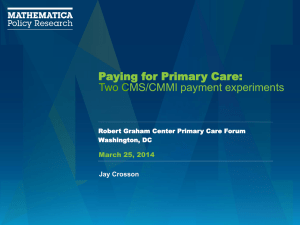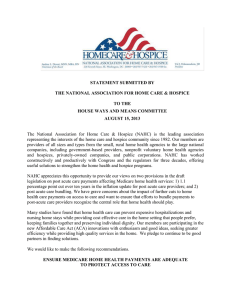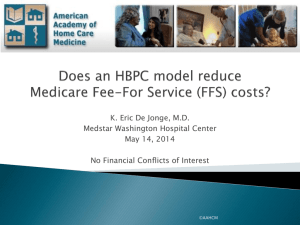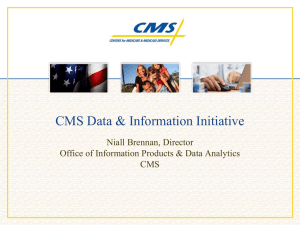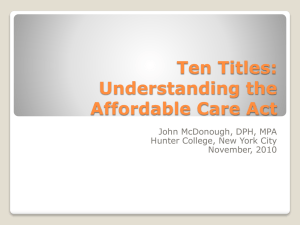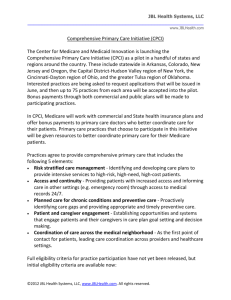New Models of Care
advertisement
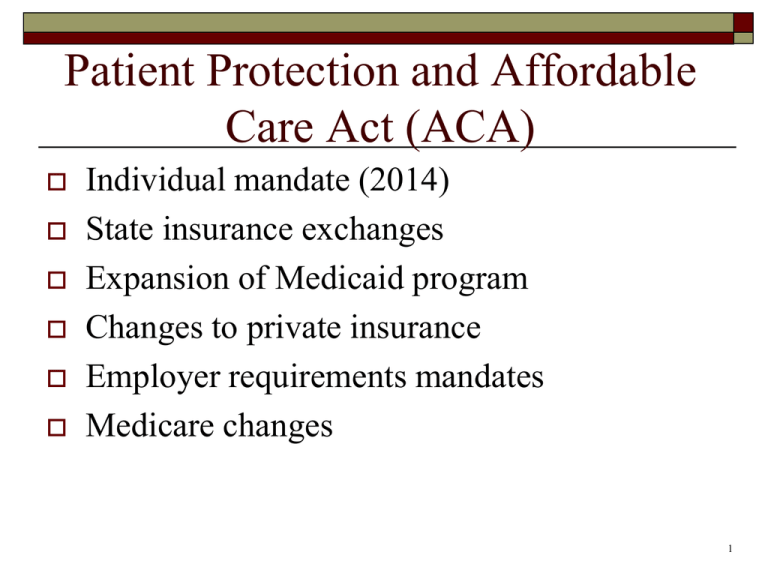
Patient Protection and Affordable Care Act (ACA) Individual mandate (2014) State insurance exchanges Expansion of Medicaid program Changes to private insurance Employer requirements mandates Medicare changes 1 Untruthful Assertions Cuts Medicare by $1000 per person Both ACA and the Ryan plan reduce increases in spending in the future by over $700 billion over 10 years Establishes death panels Payment to physicians for holding advance care planning discussions was cut from the Act 2 U.S. spending much more for older ages Source: Fischbeck, Paul. “US-Europe Comparisons of Health Risk for Specific Gender-Age Groups.” Carnegie Mellon University; September, 2009. 3 4 Medicare Reduce payments to Medicare Advantage MA plans were paid 113% of FFS Some bonuses for high quality programs Balance payments to high/low areas Establishes an “Independent Payment Advisory Board” Early donut hole relief – eventual elimination Coverage for prevention services 5 6 Independent Payment Advisory Board Recommend cost savings Produce public reports – access, quality, costs Make recommendations to President and Congress Prohibited from “rationing” or “changing benefits or eligibility” or “Medicare premiums” Hospitals and hospices not subject to recommendations until 2019 7 Donut Hole Relief 2011 $250 rebate 255, 996 FL seniors received the rebate Total amount to FL seniors - $63,999,000 Part D coverage gap discounts 252,989 Ave. per senior - $600 Total amount - $151, 807,700 Kff.org, 1/7/13 8 Prevention & Wellness in FL Free preventive services 1,662,014 FL seniors received free services 70% of FL Part B enrollees (65.5% US) Annual wellness visit 151,133 FL seniors had an annual wellness visit 6.9% of FL Part B enrollees (5.4% US) Kff.org, 1/7/13 9 Older Adult Workforce Funds Geriatric Education Centers Expand Geriatric Academic Career Award to other disciplines (nursing, pharmacy, etc.) New Geriatrics Career Incentive Award Advanced training opportunities Professionals Direct care workers 10 Elder Justice Create an Elder Justice Coordinating Council Report published in May 2013 http://www.aoa.gov/AoA_programs/Elder_Rights/EJCC/ Meetings/docs/2013_05_13_EJCC-Proposals.pdf $400 million for Adult Protective Services $100 million for state demonstration grants $26 million to create Elder Abuse, Neglect and Exploitation Forensic Centers 11 New Models of Care Innovation Center at CMS Foster patient-centered care & coordination Models Accountable Care Organizations Bundled payments Medicare Coordinated Care Partnerships for patients Comprehensive Primary Care 12 Problems with Medical Payments Fee-for-service Provider (not the consumer) decides what is needed Insurance (not the consumer) pays the fees Provider is incentivized to do more Capitation (“by the head”) Insurer decides what is needed Insurer pays provider regardless of use Provider is incentivized to do less 13 Accountable Care Organizations (ACO) An organization of physicians and hospitals that agree to cost and quality targets Strong primary care base Payment is linked to quality (instead of volume) Savings are achieved through improvements in care Savings are shared between providers and CMS 14 Bundled Payments “Bundling” expenses that used to be separate Hospital admission and after care Surgery and a “warranty” Considerations Hard to predict costs Difficult cases may be avoided Doesn’t discourage unnecessary care 15 Medicare Coordinated Care Funds coordinated care for people with chronic conditions 15 programs Face-to-face meetings with client Helped with medications Facilitated communications (“hub”) Helped with transitions 8%-33% reduction in hospitalizations Cost neutral 16 Comprehensive Primary Care 4 states (OR, CO, AK, NY) Components Risk adjustment Access and continuity Non-visit services & fees Planned care for chronic conditions Patient and caregiver engagement Coordination od care 17 Partnerships for Patients Reduce hospital-acquired conditions and readmissions Elements Hospital Engagement Networks (TMH) Care Transitions (5 sites in FL) Patient and family engagement Provides resources to health care providers to better educate staff and patients/families 18 Elephant in the Room - LTC Nursing homes - $100,000/year Low satisfaction CLASS act – (part of ACA) – would have established a national LTC insurance Many become impoverished and go on Medicaid Dropped by Democrats Are some interesting new models Eden Alternative, Greenhouse Model 19 20 1 1 – Affordability & Access - 35 2 – Choice of setting & provider - 41 2 3 4 5 4 – Support of family caregivers - 40 5 – Effective transitions - 14 3 – Quality of life & quality of care - 43 State Scorecard on LTSS Commonwealth/AARP 2014 21 Few Good Things in LTSS in ACA National panel of LTC experts Report issued Sept. 2013 Funding for LTC Ombudsman Program Funding for LTC training and recruitment Nursing home transparency Some financing options Money follows the person Home health and HCBS 22 Nursing Home Transparency Disclose ownership, financers, etc. Take steps to reduce violations Establish quality assurance programs Provide dementia care training Data collection requirements Pilot program – extend to all states a national criminal background check system 23 Good Resources Kaiser Family Foundation CMS Innovation Center http://www.edenalt.org Greenhouse Project http://innovation.cms.gov/initiatives/#views=models Eden Alternative http://kff.org http://thegreenhouseproject.org Autumn Blossoms http://autumnblossoms.org 24


